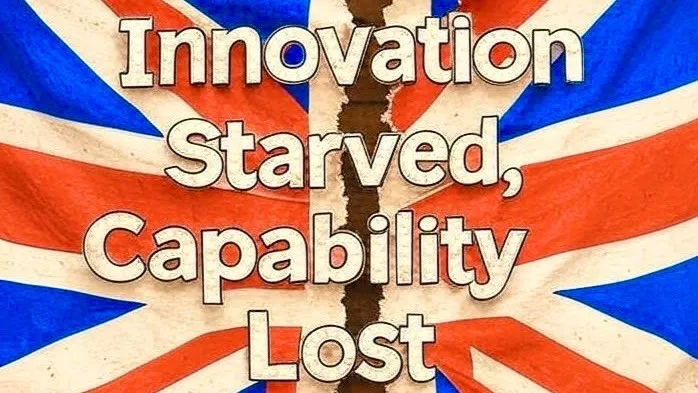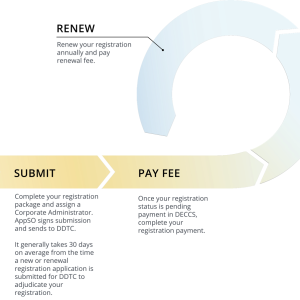The United Kingdom’s defence innovation pipeline is seizing up. Two UK-verified, government-backed programmes—one in decisive autonomous strike and another in electronic warfare (EW) pulse—are now in financial limbo, emblematic of a wider UK defence procurement paralysis that is starving credible suppliers of capital, time, and urgency. The consequence is strategic: capability atrophies while adversaries scale.

These warnings do not surface in a vacuum. Across the UK economy, distress indicators are flashing amber. Begbies Traynor’s Q2 2025 Red Flag Alert recorded 49,309 businesses in critical financial distress, up 21% year-on-year, with broad-based pain across 22 sectors. Insolvency statistics for July show company failures elevated versus late-2024 levels, even as GDP ticked up 0.3% in Q2. In parallel, small-business sentiment has flipped: for the first time on record, more firms expect to shrink, sell or close than to grow—conditions that punish innovators trying to cross the valley from prototype to production.
Inside defence, the structural critique is well documented. Parliament’s Defence Committee has called the procurement system “broke,” and the National Audit Office’s work on the Ajax armoured vehicle programme is now a case study in how process can outrun performance. The Ministry of Defence’s Integrated Procurement Model (IPM) promises spiral development and faster delivery—but the question is execution speed and culture, not aspiration.
“Delay kills innovation. Silence kills capability.”
sUAS News op-ed on supply-chain gridlock and missed opportunities
A widening gap between rhetoric and delivery
In the sUAS News op-ed that triggered this debate, two programmes of record—one showcased in national media as the pinnacle of British next-generation drone attack capability, another ratified by DASA—are described as stalling because investment cannot move at speed. Whether or not readers agree on the particulars, the pattern aligns with a broader UK defence procurement paralysis: lengthy onboarding, opaque risk gates, and weak engagement discipline that drain SME runway.
The opportunity cost is now strategic. Germany’s Bundeswehr is moving to scale: public plans indicate a surge from ~600 to more than 8,000 UAS by 2029. Ukraine reportedly supplies roughly 200,000 FPV drones per month. Russia, for its part, launched a record 6,129 Shahed-type drones in July alone—mass that stresses Western air defence and EW inventories every night. Against that backdrop, slow Western fielding timelines and capital indecision are messages, not just metrics.
Why spiral delivery must be the default
The IPM’s emphasis on spiral delivery is sound engineering logic: ship a minimum deployable capability, iterate through software and modular payloads, and shorten the user–supplier feedback loop. That is how you break UK defence procurement paralysis. The model’s success, however, hinges on behaviours inside primes and buyers: reply fast, route to technical owners early, and commit to paid trials measured in weeks—not quarters. :contentReference[oaicite:5]{index=5}
Across the Atlantic, the direction of travel is clearer. The Pentagon’s Replicator initiative set an 18–24-month target to field thousands of attritable autonomous systems, while the Defense Innovation Unit (DIU) reports sustained prototype transitions and a multibillion-dollar production pipeline. None of these is are panacea, but the bias-to-field stands in sharp contrast to Europe’s hesitation cycle.
What must change now—inside firms and in Whitehall
Answer the inbox with SLAs. Set a two-working-day standard for initial responses and a two-week horizon for a technical screening or clear “no.” This simple operating discipline, repeatedly highlighted by founders, is the lowest-cost way to relieve UK defence procurement paralysis. :contentReference[oaicite:7]{index=7}
Phase assurance to risk. Gate compliance applies to the transaction. If a firm is not yet supplying controlled items, do not demand a full defence-grade security pack up front. Phase the evidence, align to real risk, and reduce deadweight loss in time and cash.
Put engineers in the loop early. Novel sensors, autonomy stacks, and EW payloads cannot be fairly assessed by commercial teams alone. Route qualified suppliers to empowered technical huddles that can green-light a lab demo fast.
Fund rapid trials. Carve out small budgets for paid evaluations with explicit success criteria. If it works, move to limited production call-offs; if not, close out with feedback. That is how spiral delivery stops being a slogan.
Clean up “sovereign” claims. Disclose imported core systems where relevant. Buyers can still choose them—but with open eyes about supply-chain exposure.
Pay on time. If SMEs are strategic to resilience—and they are—then the practice must match the Prompt Payment rhetoric. Late payments are runway theft.
The government’s part. Enforce prompt payment with teeth tied to eligibility for major contracts. Publish a living six-month pipeline of repeatable, low-value buys (sensors, radios, datalinks, training kits, software tools). Expand matched equity for national-security tech and remove redundant steps in debt markets. These are targeted, fast-acting relief valves for UK defence procurement paralysis.
Context: the mass problem is already here
Germany’s 2029 UAS target, Ukraine’s month-on-month FPV surge, and Russia’s record Shahed tempo point to a common operational truth: massed, networked, affordable autonomy is now a core variable of deterrence and warfighting. The West does not have the luxury of 8- to 12-year acquisition cycles for counter-UAS, interceptors, loitering munitions, or EW effectors. The cost curve has bent now. :contentReference[oaicite:14]{index=14}
Implication for the UK. The nation still has deep technical benches in autonomy, RF engineering, power electronics, mission systems and AI. But without rapid triage, paid trials, and incremental production pathways, those benches will migrate—first in sales focus, then in incorporation, then in jobs. That is how capability and sovereign options erode in plain sight, one unanswered email at a time.
Conclusion
The UK still has the talent, IP and industrial base to compete. What it lacks—right now—is operational tempo in decision-making and capital deployment. If industry leaders and officials want a different headline than “innovation starved, capability lost,” the fix starts with execution hygiene: reply, assess, decide, buy, integrate. Do that at pace and the UK defence procurement paralysis can be broken before more capability slips abroad. :contentReference[oaicite:16]{index=16}
Further reading
- Source op-ed: Defence Paralysis: Innovation Starved, Capability Lost (sUAS News).
- UK Parliament: “It is broke — and it’s time to fix it”: Defence procurement.
- MoD: Integrated Procurement Model (IPM).
- NAO: The Ajax Programme.
- ONS: GDP, Q2 2025 (+0.3%).
- Begbies Traynor: Red Flag Alert, Q2 2025.
- FSB: More firms expect to shrink than grow.
- DoD/DIU: Replicator 18–24 month target; DIU annual data.
- Germany: Bundeswehr to ~8,300 UAS by 2029.
- Russia: 6,129 Shaheds launched in July.
Internal link: US Navy–Marine Corps AI & Data Strategy (Defence Agenda).
External link (additional): Reuters update on Replicator funding.
Author’s note: This article synthesizes the op-ed’s claims with verified public data and official documents. Where the op-ed references unnamed programmes, we preserve attribution and avoid speculation.












